How B2Bs Can Make Their Content Marketing Perform Better

For many years now, SEO and content marketing have been inextricably linked together. Creating content for websites is often cited as a top content marketing initiative. Yet getting search engine rankings as a result of these efforts is cited less often. Why is that?
For B2Bs that want to both create website content and get measurable results like search engine rankings and organic traffic, this article is for you. In this article:
- How B2B does content marketing
- How to do content marketing better
- FAQ: How can B2Bs align their content marketing goals with measurable results?
How B2Bs Are Doing Content Marketing
I am going to start with some interesting facts before giving you my thoughts. Content Marketing Institute’s 11th Annual B2B Content Marketing Benchmarks, Budgets, and Trends report reveals a lot regarding content marketing and SEO opportunities.
In looking at the data in the report, we see that online content falls into the top activities of a content marketing program. Creating articles was the No. 1 type of content tactic. And posting it on a B2B company’s blog or website was among the top three channels.
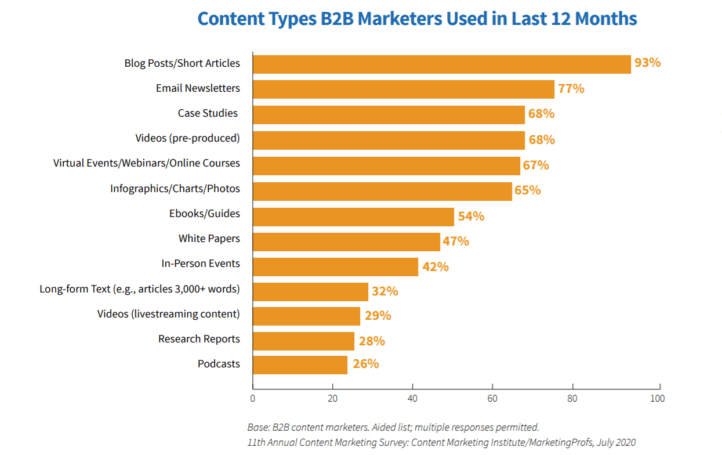
Blog posts/short articles listed as the top content type
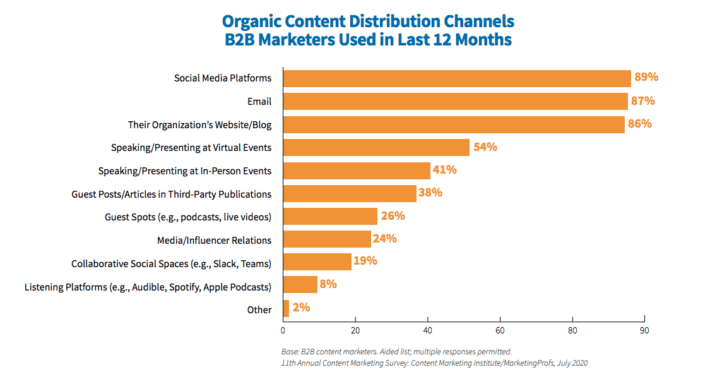
An organization’s website and blog listed as the No. 3 most used channel
Yet the majority of respondents reported their content marketing strategy was only “moderately successful.”
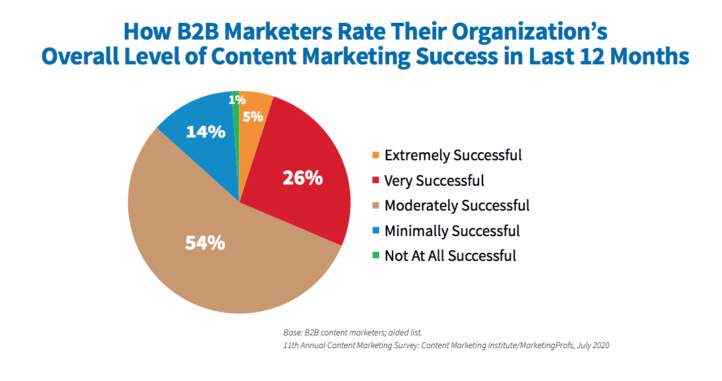
How B2Bs rate their content marketing success
Sixty percent said the creation of new web content contributed to their success. However only 37% reported search engine rankings as a marker of their results. I’ll touch on this problem more later in the article.
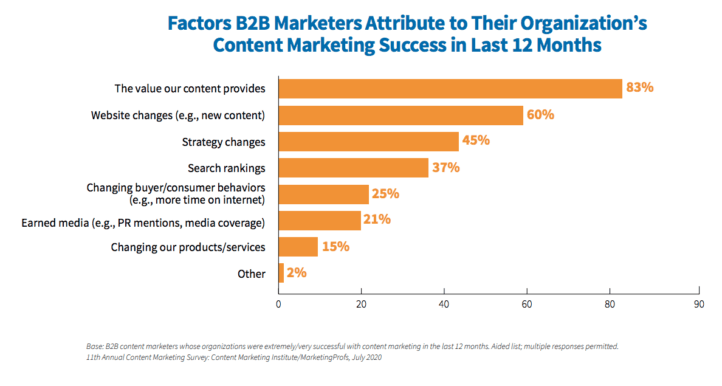
Factors B2B marketers attribute to success
In the chart below, you see that 78% percent used keyword research as an editorial tool while creating content. This is a promising data point. Why, then, aren’t search engine rankings either more attainable or more important as a result of their content creation efforts? Could it be missed opportunities for optimization?
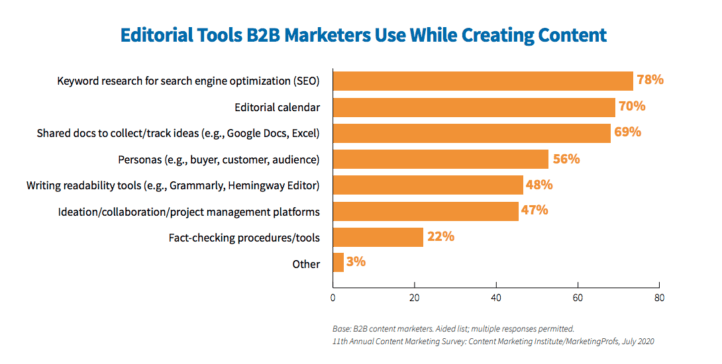
Keyword research favorited by B2B content marketers
In some good news, guest posting articles dropped 10 percent since the last CMI survey. From the data alone, it’s impossible to know why, but could it be that companies are starting to catch on that guest posting is bad for business?

Guest posting losing popularity for B2B
How B2Bs Can Make Their Content Marketing Perform Better with SEO
It’s obvious to me that many B2B companies want to succeed with their content marketing strategies, but I think that their KPIs are off. Creating content is not a KPI. How that content performs is.
Of course, many may say that creating brand awareness and creating value are goals. And that is fine if you can measure them. But if your main activities are creating content for your website, one goal should be rankings — and the traffic, engagement, and sharing that come with rankings. Content unread is not a goal.
Here are several questions that B2Bs can ask to ensure their content marketing goals are supported by measurable results.
Does Your Content Prove Expertise and Authority?
What I’m about to say may sound like a broken record for some. You need to focus on the quality of your content, not the quantity. Simply creating content for a website as a goal ignores what’s most important: the contents of what you produce.
Google’s Search Quality Evaluator Guidelines detail how expertise and authority play into quality. Our article on the Complete Guide to the Fundamentals of Google’s E-E-A-T explains how to achieve it with your content.
Bottom line: Your content needs to be written at an expert level for the topic and be authoritative on the subject matter.
Are You Using the Right Tools When You Create Content?
Keyword research is essential, and it’s nice to have target search terms when you are creating content. However, how you analyze those keywords and optimize the content with them can make or break how the content performs in the search results.
For example, say your SEO person has done the keyword research. They hand this off to the content creator with instructions to include the key terms in the content. If that is the complete strategy, is it any wonder that the content doesn’t perform?
You must go deeper. You must be able to take those keywords and find out who the competition is in the search results for that query. You need to understand what they are writing about around that key term and how. Then you need to meet or beat them to have a better chance to rank.
Our WordPress SEO plugin can help B2Bs here. It gives you real-time data by analyzing the top-ranked pages in the search results with targets for things like metadata, readability score, and word count. For more on this, read: Want Customized SEO Advice Per Keyword? There’s a Plugin for That!

Bruce Clay SEO WP plugin summary tab
Why guess when you can get all the data you need to really compete?
Are You Optimizing the Content Thoroughly?
Optimizing a page with keywords is one of the most common tasks that a content creator does when creating content for a website. But the question often remains: Are they doing it well enough?
While keyword optimization happens naturally while writing about a topic, there’s always more you can do to help the content perform better.
I’m going to recommend our WordPress SEO plugin here again. It can show content creators how many times to use the key term based on real-time analysis of the top-ranked pages. Plus, it has a nice visual that shows you’ve used the term throughout the content from top to bottom (which may impact the relevance of the content to a search).
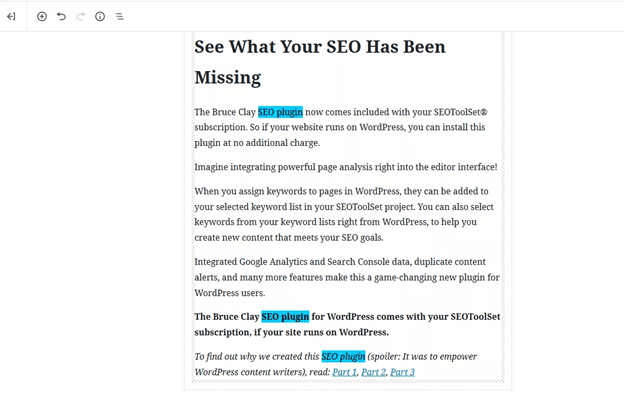
Keyword distribution visualized in Bruce Clay SEO plugin
For more, check out: How a WordPress SEO Plugin Can Help you Optimize Your Content with Keywords.
It’s been over a decade since we started using the term “content marketing.” And yet, it still feels like B2Bs are challenged when it comes to how to get the most from it.
Search engine optimization is a supportive strategy for any content marketing program. It can boost results on your most important digital business asset: your website.
If you’re looking for help with your content marketing strategy or SEO, let’s talk. Fill out our quote request form today.
FAQ: How can B2Bs align their content marketing goals with measurable results?
Effective content alignment starts with setting clear and concise goals. B2Bs should define brand awareness, lead generation, or thought leadership objectives. These goals serve as a compass, guiding content creation towards specific outcomes.
Quality over quantity remains the cardinal rule in B2B content marketing. Crafting content that resonates with the target audience requires in-depth understanding. Conduct thorough research to identify pain points, industry trends, and pressing questions. Tailoring content to address these aspects enhances engagement and contributes to measurable results.
Leveraging the right distribution channels amplifies the impact of B2B content. Whether through industry-specific publications or social media platforms, reaching the intended audience is crucial. Moreover, a consistent posting schedule maintains relevance and keeps the audience engaged over time.
However, true alignment with measurable results comes from harnessing the power of data and analytics. B2Bs should integrate robust analytics tools to track key performance indicators (KPIs). This offers insights into what works and what needs refinement. Analyzing metrics such as conversion rates, click-through rates, and engagement levels provides a clear picture of the content’s effectiveness.
B2B content marketing success lies in aligning goals with measurable results. By defining precise objectives, creating tailored content, utilizing effective distribution channels, and leveraging data-driven insights, businesses can drive engagement, nurture leads, and ultimately achieve their content marketing goals.
Step-by-Step Procedure: Aligning B2B Content Marketing Goals with Measurable Results
- Define Clear Objectives: Set specific goals for your content marketing campaign, such as lead generation, brand awareness, or customer retention.
- Audience Research: Conduct thorough research to understand your target audience’s pain points, preferences, and behaviors. This insights-driven approach informs content creation.
- Tailored Content Creation: Develop high-quality content that addresses the identified pain points and aligns with your objectives. Focus on providing value and solving problems for your audience.
- Distribution Channel Selection: Choose the most relevant distribution channels based on where your target audience is active. This could include industry publications, social media platforms, or email newsletters.
- Consistent Posting Schedule: Establish a consistent posting schedule to maintain audience engagement. Consistency helps build anticipation and keeps your audience coming back for more.
- Data Integration: Implement robust analytics tools to track key metrics such as conversion, click-through, and engagement levels.
- Performance Analysis: Regularly analyze the gathered data to measure the effectiveness of your content. Identify patterns, trends, and areas for improvement.
- Iterative Refinement: Use the insights from your data analysis to refine your content marketing strategy iteratively. Adjust your content, distribution channels, and posting schedule as needed.
- A/B Testing: Experiment with different approaches through A/B testing. Test content variations, headlines, and visuals to identify what resonates best with your audience.
- Conversion Optimization: Optimize your content for conversions by including clear and compelling calls-to-action (CTAs) that guide readers to the desired actions.
- Lead Nurturing: Develop a lead nurturing strategy that delivers targeted content to prospects at different stages of the sales funnel.
- Sales and Marketing Alignment: Foster collaboration between your sales and marketing teams to ensure that content aligns with the needs of potential customers.
- Content Audit: Periodically review and assess the performance of your existing content. Remove outdated or underperforming content to maintain a high-quality content portfolio.
- Competitor Analysis: Monitor your competitors’ content strategies to identify gaps and opportunities within your approach.
- Feedback Integration: Gather feedback from your audience and internal teams to gain insights and make informed adjustments.
- Long-term Vision: Keep a long-term perspective, understanding that content marketing success often requires consistent effort and adaptation.
- ROI Evaluation: Continuously evaluate your content marketing efforts’ return on investment (ROI) by comparing the achieved results with your initial objectives.
- Staying Updated: Stay informed about industry trends, algorithm changes, and evolving audience preferences to remain relevant and effective.
- Team Education: Educate your content marketing team about the latest strategies, tools, and techniques to ensure continuous improvement.
- Celebrate Successes: Recognize and celebrate milestones and successes achieved through your aligned content marketing efforts. This boosts morale and motivation within the team.
By following these steps, B2Bs can systematically align their content marketing goals with measurable results, driving success in the competitive B2B landscape.
This article was updated on December 21, 2023.

10 Replies to “How B2Bs Can Make Their Content Marketing Perform Better”
I think the content you share is interesting, but for me there is still something missing, because the things discussed above are not important to talk about today.
Thanks for sharing the useful content. Still, many businesses do not give enough emphasis on content marketing where it can ensure a better ROI.
Content marketing can be a great tool for B2B businesses if it uses properly. Great content so far.
Yes. it all means the quality of the content is the first aspect how this method can work properly. B2B or B2C in SEO need a quality content. that’s it.
New marketing methods, such as social media marketing, are helping to improve this trend.
Thanks for great article. More and more often, I feel that everyone is writing the same thing and going in one direction. “Big valuable content” – it starts to lose its meaning and even becomes boring. The truth is that valuable content is good to develop artificial intelligence, not for users. The machine learns faster from one extended context than 20 folded contexts. I know from experience that most people cannot read an article longer than 1000 words, and they usually do so during their lunch break or on the bus. Unfortunately, if you want to be ranked high, you have to write. It is a pity that the most exciting content is usually in the comments and forums.
Good content is one thing, but great online content is another. Content marketing is important because it answers your audience’s questions. With content marketing, you can build trust with your audience, improve conversions, connect with your customers, and generate leads. Additionally, in today’s age, customers expect high-quality, consistent content from their favorite brands.
LEAVE A REPLY









